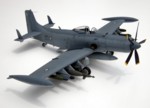 This is a hypothetical model of a turboprop powered Skyraider, similar in concept to the Piper Enforcer turboprop Mustang. The base kit is Tamiya's excellent 1/48 scale Skyraider kit.
This is a hypothetical model of a turboprop powered Skyraider, similar in concept to the Piper Enforcer turboprop Mustang. The base kit is Tamiya's excellent 1/48 scale Skyraider kit.
Planes Gallery
Hello and welcome to the Planes Gallery. Like cars, I enjoy a variety of aircraft models. Often I will do a "custom" aircraft just as I do custom cars; these hypothetical models are sometimes just more fun than an accurate reproduction of actual aircraft -see below. All copywrited ©2004 G. Plummer
 This is a hypothetical model of a turboprop powered Skyraider, similar in concept to the Piper Enforcer turboprop Mustang. The base kit is Tamiya's excellent 1/48 scale Skyraider kit.
This is a hypothetical model of a turboprop powered Skyraider, similar in concept to the Piper Enforcer turboprop Mustang. The base kit is Tamiya's excellent 1/48 scale Skyraider kit.
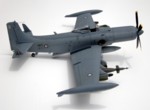 Besides the engine other mods include wing tip tanks, leading edge slats, a non-folding wing, a differnet pylon arrangement and advanced avionics. The paint is 3 tones of Testors gray enamels and the markings are from an Austrailian decal sheet. Why Aussies? I liked the little kangaroos....
Besides the engine other mods include wing tip tanks, leading edge slats, a non-folding wing, a differnet pylon arrangement and advanced avionics. The paint is 3 tones of Testors gray enamels and the markings are from an Austrailian decal sheet. Why Aussies? I liked the little kangaroos....
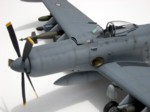 The engine was made from a Sea Fury cowl glued to the Skyraider cowl and epxoy putty. The exhausts are brass tubing. The propeller is 5 1/48 scale A-26K blades and the Fury spinner. The cockpit HUD is cut from irridescent gift wrapping ribbon and shines green when the light hits it.
The engine was made from a Sea Fury cowl glued to the Skyraider cowl and epxoy putty. The exhausts are brass tubing. The propeller is 5 1/48 scale A-26K blades and the Fury spinner. The cockpit HUD is cut from irridescent gift wrapping ribbon and shines green when the light hits it.
This is Italeri's so-so Corsair kit with floats added on from a Kawanishi Rex kit. The Royal Navy did have Corsairs, but a float plane version never exsisted obviously. Would have made an awesome catapult launched aircraft, though.
The paint scheme is the lovely Extra Dark Sea Gray over Sky. Decals are from the parts box. The model is carefully finnished to look believable. Fools a few people ("I've never seen the float plane version before") - very saisfying.
Hasegawa's Ki-61 painted in Italian markings. When the Ki-61 appeared in the Pacific theater it was incorrectly thought to be a copy of an Italian Macchi with it's inline engine, hence the code name of "Tony." It does look pretty close to a Macchi 202 when painted as such. The Hasegawa Tony is a fine kit, as is their Machi 202...
The Shinden was a late war experimental aircraft with a rear mounted engine and pusher prop. The improved forward view and concenrated fire power in the nose would be the advantage of this design, but in actual flight engine torque was a problem. Otherwise the plane appeared to perform well. This is Hasegawa's 1/48 scale kit, modified into a racer for a club contest we were having.
The fin tips were rounded and the front elevators taken from a 1/72 scale Cougar kit to give the plane a race look. The paint is pearl orange over copper, with black antiglare panels to resemble the Japanese prototype schemes. Decals are from a Tamiya Jaccs Accord kit with Microscale roundels. The center canopy piece was replaced with sheet clear plastic.
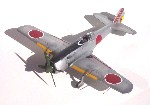 Hasegawa's excellent 1/48 scale Ki-83 kit done in a natural metal scheme from the Phillipine theatre. The kit is out of the box and painted in Testor's Metalizers. The Decals are from an Aeromaster set.
Hasegawa's excellent 1/48 scale Ki-83 kit done in a natural metal scheme from the Phillipine theatre. The kit is out of the box and painted in Testor's Metalizers. The Decals are from an Aeromaster set.
 The only fault with this kit is that the landing gear are held in with poly caps. CA glue is a recomended replacement to avoid wobbly gear. The Ki-83 Frank itself was the best Japanese fighter of the war; its only fault was poor build quality.
The only fault with this kit is that the landing gear are held in with poly caps. CA glue is a recomended replacement to avoid wobbly gear. The Ki-83 Frank itself was the best Japanese fighter of the war; its only fault was poor build quality.
 This is Hasegawa's 1/72 scale Draken in Danish air force markings. A recon nose from the Heller kit has been added, and the Heller decals were used also.
This is Hasegawa's 1/72 scale Draken in Danish air force markings. A recon nose from the Heller kit has been added, and the Heller decals were used also.
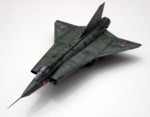 Danish aircraft were painted in an overall olive drab that weathered heavily. The Drakens usually had better paint than the F-100s.
Danish aircraft were painted in an overall olive drab that weathered heavily. The Drakens usually had better paint than the F-100s.
This real scheme is a Mig-21 from the Indian Air Force of the early 70's. The kit is Fujimi's 1/72 scale Mig-21 "Indian Tiger" boxing; the model is out of the box and the decals are from the kit.
The dark green "tiger stripes" were airbrushed over the pale green, while the bottoms of the wings are in natural metal. The Fujimi kit is complex but goes together well. I lost the large pitot tube that goes over the front of the intake - that's what moving will do sometimes.
Avro Canada's CF-105 Arrow was a high performance interceptor of the late 1950's, canceled after 5 were built by a newly elected conservative Canadian admisistration. Avro tried to sell the plane to the British, who already had the Lightning and didn't buy the Arrow. This Hobbycraft model is a version of what a British Arrow may have looked like. The cockpit and landing gear detail on the kit is mostly absent, what is there is incorrect, but otherwise the model builds well.
Azur's nice 1/72 scale Cierva C-30 kit built with Spanish markings. If you don't know about autogyros, they're really more like a small plane with rotating wings than a helicopter - autogyros cannot hover. They make neat models however. Like any limited run kit, there is a lot of cleaning up and test fitting involved in building, and many of the smaller kit parts are best thrown away and redone in plastic rod or sheet.
Another autogyro, this one being Fine Molds' Kayaba Ka-Go (O-Go) model kit. Built out of the box with teeny-tiny scratchbuilt windscreens. The KaGo is really another variation of the Cierva design (see above); Cierva was the Spainish engineer that perfected the autogyro if one could call them perfected. Fine Molds kits are hard to get and expensive in the states; I got this one in Japan, but that's another story.
This is Hasegawa's F-18 in their Egg Plane series. This was a newer kit and didn't have a neat little diarama that earlier versions have. I had no choice but to build one myself, with a Hamtaro as a cat officer. Should have used a cat as a cat officer... I also dropped the flaps and repositioned the elevators on the plane. Don't worry, I quit drinking soon after.
Revell of Germany's excellent 1/144 scale Rafalle M kit out of the box.
This a Dragon models 1/400 scale Airbus A-380 in Air China colors. A simple kit, it is basically an unassembled version of their desktop series.
In the mid 90's, Special Hobby put out a line of 1/72 scale light U.S. helcopters using limited run technology. These unusual subjects were designed to drive modelers crazy, as they were tiny, complex, poorly molded, and not available in kit form anywhere else. Fortunately, I'm already nuts so I wasn't affected. This is the Osage kit done in Japanese markings - the kit decals have many options and are beautiful.
Most of the tube frame was scratch built using plastic rod (I spent almost as much on the various sizes of rod as I did on the kit) The rotors and tail planes are also built out of plastic card. The finnshed model is about 10cm long.
This is Hasegawa's 1/48 Macchi 205 kit in the Egyptian Air Force boxing. A nice kit with few flaws. Many Egyptian Macchis were painted in British desert colors like their Spitfires, but this one wears a pretty factory chestnut brown over gray color scheme. The Scale Master kit decals were used, but the white was very translucent on these...
The Macchi 205 was a fine aircraft, but in the hands of Egyptian pilots they served mainly as target practice for the then new Israeli Air Force (Chel l'Avir) - not that the Italians did much better with them.
Hasegawa's 1/48 scale Ki-44 Shoki (code name Tojo) in the markings of Japanese ace Yoshio Yoshida. Generally an excellent kit with only a minor fit problem on the wing roots. The Tojo was a very unique looking plane with its forward set horizontal stabs.
The bare metal finnish is Tamiya's spray. This was a little too "paint like", so I sprayed Metalizer on top of that. All the markings are airbrushed on excpet for the kill markings and fin flash. The weathering was done with a highly thinned mix of black and Dullcote.
Uh, yeah, they flew them. Fujimi kit...
This is Hasegawa's 1/72 scale F-104G Starfighter kit done with Micro Scale decals. The special scheme was probably to celebrate a year of flying F-104s without driving one into the ground. Pretty colors...
The black, red, and yellow paint was all masked off and airbrushed. A Verlinden cockpit detail set was used, which added a lot compared to the kit interior.
Another Hasegawa F-104 in 1/72 scale, this time in Canadian special markings. The large side marking is an arrow, not a toothbrush. Hasegawa's kit is excellent in fit and surface detail, and includes all the correct wheels and electronic bulges for each version.
The Starfighter looks good in any scheme, except for maybe those dull colored German versions, but it looks espially good in all red. There's an Italian special marking that's also all red, but I've built enough Starfighters for now...
More to come later, thanks for your support.